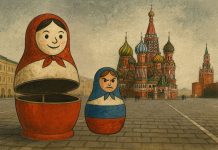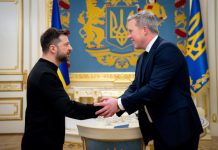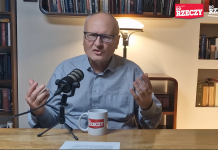“A mixed crowd with competing messages appeared at the gargantuan Soviet Memorial in Berlin’s Treptower Park during World War II victory celebrations,” writes Mykyta Vorobiov.
By Mykyta Vorobiov, for CEPA
It would be tempting (but wrong) to assume the thousands who came to Berlin to celebrate Nazi Germany’s World War II defeat were all admirers of the Kremlin. Or haters of NATO and nostalgic for the good old days of Russia’s colonial commissars running regimes in the heart of Europe.
But they were there for sure. The event underlined that while history may be what’s behind us, it’s also ever-present in the here and now, and telling us a story of unresolved differences.
The memorial was draped with pro-Russian propaganda, including claims that Ukraine had provoked Russia’s all-out war, descriptions of that NATO as a Nazi organization, and more, much more, that would warm the Kremlin’s heart.
The Russian Ambassador to Germany delivered a speech in the morning, and the representatives of Russian state-directed media were present, looking for confrontations between the protesters holding Russian flags and the police, who had banned certain expressions of extreme nationalism like St George’s ribbons.
There were xenophobic chants and modern pro-war songs to contradict the stated aim of the annual event, which self-describes as a tribute to the Soviet troops who died to defeat the German Reich.
For many years, the Soviet memorial in Berlin has been the final shrine of a pilgrimage of those willing to celebrate Victory Day on May 9 (the former Allied nations of the West mark the end of hostilities on May 8).
Every year, motorcycle rallies from Russia to Berlin were organized, where bikers embellished with the signs “We can repeat [Russia’s Victory],” “To Berlin,” and similar statements, travelled a long way as a supposed homage to the route taken by Soviet soldiers to Berlin during the “Great Patriotic War.”
Russia’s all-out war against Ukraine in 2022 brought change, and not in a good way. The event became more politicized, attracting not only those willing to commemorate fallen Soviet soldiers but also Western so-called Putin-huggers. The Moscow-Berlin motorbike rallies no longer take place, and it has become harder for people to come to Berlin from Russia, but that doesn’t prevent the gathering.
This year, masses gathered near the memorial. There were many Germans, as well as visitors originating from the post-Soviet countries. As in 2023 and 2024, Berlin police introduced strict regulations around the memorial to prevent the more offensive iterations of modern Russian ultra-nationalism.
Russian and Soviet flags, as well as Saint George’s ribbons and other symbols of the war, such as the letters Z, V, and O, were forbidden. When the rules were violated, police whistled as a warning and then confiscated the offending items. Around noon, after a man started to wave a big Russian flag on the memorial and refused to give it away, police used force to take it from the protester. The crowd filled the air with the “Nazi Schweine (Nazi pigs)” shouts towards the police. The irony of such language aimed by people with an open affection for despotism at the officers of a law-governed democracy was, needless to say, lost on them.
The police, anyway, had only limited success. While large flags were confiscated, T-shirts with pro-war symbols were visible everywhere.
The event attracted representatives of the German far left. Combining communist statements with the flags of Palestine, Yemen, Vietnam, and, in some cases, North Korea, they used the event as an opportunity to accuse NATO of imperialism. Indeed, anti-NATO sentiment was a red thread throughout the gathering, with people verbally attacking anyone with a NATO flag and blaming the war in Ukraine on NATO expansion. They were, in this sense at least, openly echoing Russian propaganda.
Ukrainian flags were allowed and were waved by dozens of protestors from Germany, Russia, and Ukraine. This brought confrontations between the pro-Russian and pro-Ukrainian sides.
But probably the most interesting contrast was between the Germans on each side of the barriers, who debated across the divide.
At this point, it became apparent that not all visitors were Putin admirers. Since the fight against Nazism is a crucial event in modern German history, many older adults, especially those raised in the former East Germany, see the anniversary not as a pro-Russian gathering, but as a commemoration of the fallen soldiers who liberated Berlin. Indeed, the lion’s share of Germans commemorating Victory Day this year were from this group. Some but not all are pro-Putin.
Pro-Russian or otherwise, they are filled with grievance. A noticeable number of GDR flags were present, signaling Germany’s continuing polarization 35 years after the reunion. East Germans are far more likely to vote for the ultranationalist AfD.
East Germans still feel underrepresented in the government and life of the country. Only one of the seven new Merz’s CDU ministers is from the former GDR, pointing to this structural issue. Only 1.7 per cent of the top positions in Germany are held by Germans from the former GDR. The difference between the former East and former West is visible even in salaries, where East Germans earn 17% less for the same job than those in the West. This is fertile territory for Russian propaganda, which seizes on discontent about inequality and “second-class citizens”.
At least until these issues are addressed, the protesters are likely to return next year and the year after, bringing back their festival of grievance and discontent.
By Mykyta Vorobiov, for CEPA
Mykyta Vorobiov is a Ukrainian political adviser, journalist, and political science student at Bard College Berlin.
Europe’s Edge is CEPA’s online journal covering critical topics on the foreign policy docket across Europe and North America. All opinions expressed on Europe’s Edge are those of the author alone and may not represent those of the institutions they represent or the Center for European Policy Analysis. CEPA maintains a strict intellectual independence policy across all its projects and publications.





